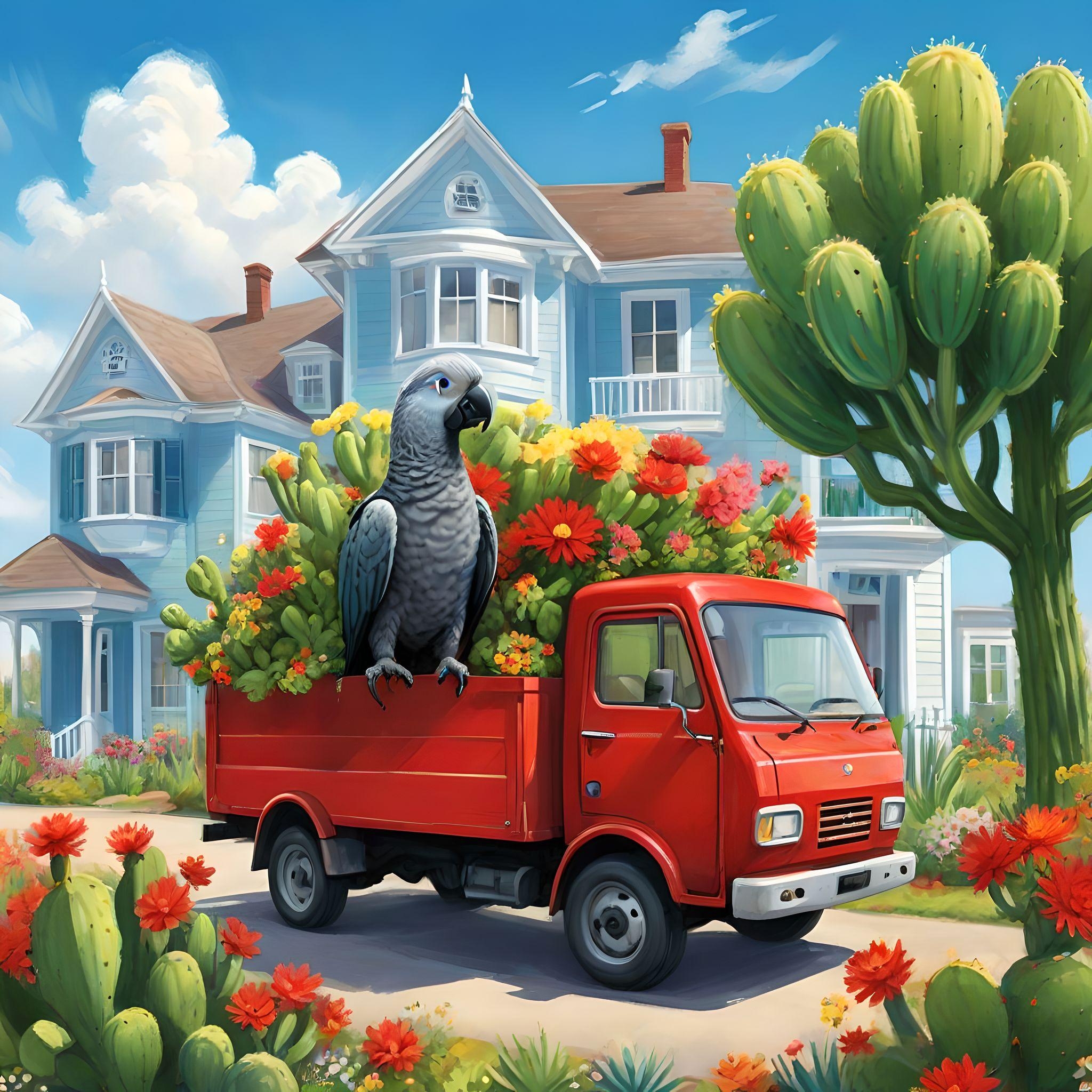And …
What To Do When You Receive Plants
From Others
And …
Moving Your Entire Collection
Marina Welham
![]()

How to Send Succulent Plants by Mail
Cacti and succulents can safely be sent through the mail, but if you are mailing plants from one country to another, you should contact the Plant Protection Division of the Department of Agriculture for that country to find out what the guidelines are about plants you are allowed to mail and where you can mail them. The purpose of this article is only to tell you how to mail them.
People who have been growers of non-succulent plants may not be aware that succulent plants, including cacti, can be successfully mailed from one person to another and an entire collection can be packed and moved along with household belongings if you are moving your home from one place to another.
The unique thing about cacti and succulents is their ability to survive without any moisture for reasonable periods of time. They are therefore ideally suited to mailing or transporting, either with their roots or without their roots.
Here’s how to proceed.
1. Shake all soil off the roots of the plants, being careful to break as few roots as possible. Don’t worry if a few roots are broken. That won’t kill the plants. It is much easier to remove the soil if it is dried out. Don’t try to remove the soil after you water the plants!
2. Any plants that are in full growth and seem rather too juicy or turgid are safer allowed to dry out for a few days without water, which will harden the growth and then they will be less likely to bruise or rot.
3. You can trim back excessive roots if you like, again with no damage to the plant.
4. Make sure the plant and roots are very dry. Succulents travel more safely if the roots are dry. And most important, there will be less weight to pay postage on! And these days, heaven knows anything saved on postage is a bonus.
5. Prepare a label for each plant with the name of the plant on it.
6. Wrap each plant in soft paper — with the label with the name of the plant on it. If it is a delicate plant, use soft kitchen towelling. If a stronger plant, you can use newspaper. If lots of spines, use two or three layers of newspaper. I like to put a note on such plants to be careful when opening so people don’t stab themselves when opening the parcel.
7. A little different procedure is needed for a few plants such as Epiphytes, Orchid cacti or Christmas Cactus. If they have roots, they do not do as well if left dry for too long. Use a small plastic bag containing a pinch of damp peat moss and wrap it around the roots only, and secure with a rubber band. Actually, it is better to send dry cuttings of these than to send cuttings with roots. If there are no roots, you don’t need to worry about moisture — just wrap them dry.
8. An important safeguard for succulents sent through the mail is a strong, light-weight box. The best type of box is one made of corrugated cardboard. Try your hardware store, garage, drugstore or the grocery store, where you will often find these and they are usually free. If the box is too big, it is not difficult to make a smaller box out of a larger corrugated one. Just crease the folds with the back of a knife or ruler, cutting off excess where necessary.
DO NOT use cereal boxes, shoe boxes and the like and expect your package and plants to arrive uncrushed! Remember, your parcel can go hurtling along conveyor belts and down long chutes, landing in huge piles with heavier packages on top of yours. A parcel has to withstand much battering as it goes through the post office. If you don’t wrap it right, it will fall apart. You could, however, use those flimsy types of boxes, inside the box you are mailing, to contain and separate some plants from others if you are packing quite a few. I find them handy for plants with really vicious spines which insist on piercing all sorts of paper but are quite protected in a box within the box.
9. Pack sufficient extra paper (shredded paper or crumpled newspaper is good) around the individually wrapped plants in your box so they won’t shake around. Fill in also any empty spaces when all plants are put in the box. It is very important that the plants or cuttings do not move around in the box or they will damage each other.
10 . Seal the box tightly with proper tape made for wrapping parcels. Ordinary scotch tape won’t hold! Do not use string or twine or cord. They are not allowed by the post office (at least in Canada). There is no need to wrap the box again in paper. If the box has been in the mail before and there are addresses or other notations on it, strike these out boldly with a marking pen.
11. Prepare three labels. Two for the outside of the box — top and bottom and one to go inside, just in case anything happens to badly damage the outside of the box. Either print out a label on your printer or hand-print — your address in the upper left hand corner. The address of the person you are sending it to goes in the middle further down. And make sure postal codes are shown for both addresses.
12. Write on all three labels in large letters at the bottom: P E R I S H A B L E.
13. One final tip. If you send your plant parcels by regular parcel post which is the cheapest parcel rate available … and spend an extra 50 cents or a dollar to insure the parcel with the post office, you will find that it goes through the post office very fast. They do not want insured mail to get lost, so priority is given to getting it there. There is no point paying for what is now very expensive first-class mail if you do it the insurance way and save many dollars in the process. And please note, parcels sent by parcel services will often take much longer to arrive than those sent through the post office, especially if they are going outside your country.

1. When you receive a box of plants, you should open it at once. Not that you won’t! You will be eager to see the contents. The plants will be in immediate need of air and light. Be careful that the light is not too strong for a few days. Avoid putting them in sunshine. Remember that the plants are succulent, have evolved to resist evaporation from leaves or bodies and will not wilt like ordinary plants. Light and air are more urgent immediate considerations than water.
2. Put the plants in a warm, bright place for a day or two and you can, if you wish, pot them up at once in slightly moist potting compost. A light spraying now and then may help if the weather is hot and dry, but avoid this in cold or damp weather. Let indications of fresh growth guide about when to begin normal watering, as well as weather conditions and the size and type of plant. Remember that cuttings without roots will not take water up without roots.
3. For cacti cuttings without roots, larger cacti have more reserves of their own to draw on and will not likely make roots as soon as young, small ones. It is wise to plant these rootless larger plants in extremely porous gritty compost which will dry out within a few hours of watering. Or you can put a little water in the pot saucer now and again which will be taken up into the soil in the lower half of the pot so that when roots form they go down looking for that moisture. In the meantime, they are not sitting in soaking wet soil and tending to rot.
4. For plants with roots, just pot up in moist soil and watch for signs of life before you start a regular watering program.
5. Move the plants or cuttings gradually into the light they need, and some eventually into full sunshine. If you don’t know whether the plants need full sunshine, keep them in a very bright place out of full sunshine until you find out what light each plant needs.

What do you do when you have to move your place of residence for a considerable distance to another part of the country or even out of the country and have to move your entire plant collection with you?
1. Apart from the question of how to move the plants themselves, if you are moving to another country, it is important that you know there may be plant quarantine and inspection regulations that you should investigate and your Department of Agriculture is the place to direct your inquiries.
2. If the plants are to be inspected, it is wise, prior to having that done, to thoroughly soak the soil and dip all plants in an insecticide solution. This should be done long enough before moving to allow time for a couple of normal waterings to leach out the excess (and the smell to hopefully disappear) and then time for the soil to dry out thoroughly. In any event, before you attempt to pack your plants for moving, the soil in the pots should have time to thoroughly dry out.
3. If there are no restrictions about moving your plants in their pots, soil and all, you can wrap each plant, pot and soil in two or more layers of newspaper and pack them, right side up, into cartons provided by the movers. Large plants on the bottom, progressively smaller and lighter ones on top.
4. Even if shipped bare-root (no pots, and the soil removed), plants need a thorough drying out period before packing to induce a state of partial dormancy so they don’t etiolate (lengthen and grow out of shape) and otherwise suffer from the time they spend confined in wrappings, in a box and in the dark.
5. Most movers charge by weight as well as distance. If you have a very large collection and weight is a factor in the cost of shipping, you are better to move your plants bare-root with all soil removed. However, you would then be faced with the task of reporting the collection on arrival, on top of all the other chores of becoming settled in a new home. Succulents are wonderfully patient, though, and on arrival, if you can just manage to get them unwrapped and into the air and light, they will wait a few days until you can pot them up.
6. On each box of plants ready for moving, affix a large piece of white paper and with a heavy hand and a marking pen write: PLANTS — PERISHABLE on each box.
7. You must discuss with your mover the importance of packing your plants properly. If you don’t explain that you are moving perishable plants, they could be packed on the bottom of the van with all your furniture on top of them! Sometimes moving vans move the contents of more than one home in their vans. In this case, it is all the more important to arrange with your mover not to put your plants under everything else in the truck.
Bringing the plants back into growth
Bringing the plants back into growth after moving is the next consideration and can be a critical time.
1. To begin with, I cannot too much stress the importance of being extremely careful with watering, and not to over-water. Once potted up, water the plants well once and then wait for signs of growth, returning turgidity, healthy color etc. before watering again.
2. The longer plants are in a dark box in transit, the more serious damage can result if they are suddenly exposed to sunlight when they arrive at your new destination. Be extremely careful for some time (at least a couple of weeks) about sun exposure. In moving to a new home, plants may have to make do with temporary quarters and be shifted from one place to another a number of times before a proper place is readied for them. Just think twice about where you move them and realize that too much light too soon can cause as much stress as too little light for too long. Every time you change a plant’s growing conditions, the plant suffers some amount of stress.
You do not have to give up your plants or leave them behind. Cacti and succulents travel far better than most people! Your new neighbours, not familiar with cacti and succulents, are bound to be impressed with your unique collection and before you know it … many new friendships in your new location will have begun.
Rescued from The Wayback Machine.
© Copyright THE AMATEURS’ DIGEST.
![]()

